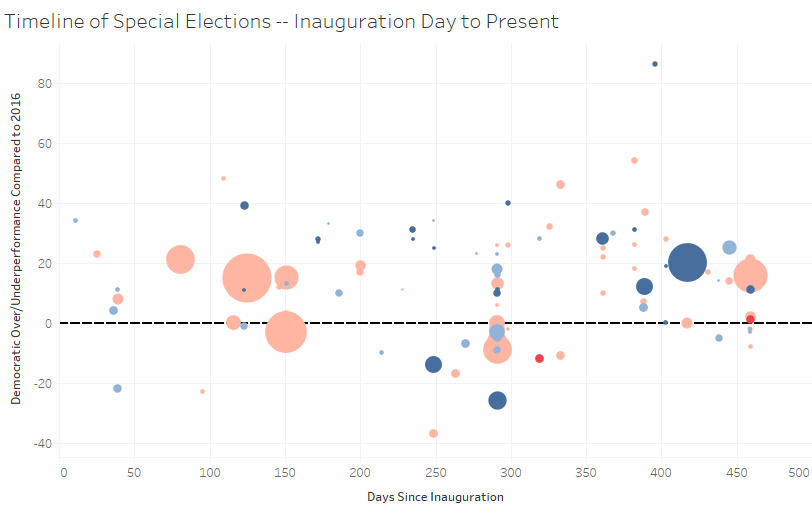Republicans might have been tempted to breathe a sigh of relief on Tuesday night. Republican Debbie Lesko won a special election in Arizona’s 8th Congressional District (vacated by Trent Franks, who resigned amidst a sexual harassment and surrogacy scandal), avoiding another high-profile defeat like the one that Rick Saccone faced in Pennsylvania’s 18th District in March.
Winning always beats losing. But Lesko’s win was far from decisive—as of late Tuesday night, her lead was roughly 5 points. That’s not great when you put it in the context of 2016 and other Trump Era special elections.

This graphic has showed up in a few of my stories, but here’s a brief primer for the uninitiated: Each point represents a special election, and they read left to right chronologically. The vertical location indicates how well Democrats/Republicans performed relative to the 2016 results—so points far above the dotted horizontal line represent big Democratic overperformances and points far below the line signal GOP overperformances. The size of each points is proportional to the total number of votes cast for major party candidates, and the color tells you whether the seat changed hands (pink means the GOP kept the seat, light blue means Democrats kept the seat, red means GOP takeover and dark blue means Democratic takeover). The exact position of Arizona 8 is based on estimates of Lesko’s margin and overall turnout, but those results may change. The other small points on this date are New York state legislative special elections (not all of which were resolved by late Tuesday night).
Arizona’s 8th is the sizeable pink bubble in the right hand side of the graphic. Trump won the district by 21.1 points, so Lesko underperformed him by about 16 points (again, this is an estimate as of late Tuesday night and is subject to change).
That’s a bit less than the underperformances posted by Rick Saccone in Pennsylvania’s 18th District (a 20 point underperformance) or Ron Estes in Kansas’s 4th District (a 21 point difference), but Lesko had advantages that Saccone and Estes didn’t. Her district was more demographically favorable than Pennsylvania’s 18th District (many old, white, “ancestrally Republican” voters), and she didn’t face as tough of an opponent as Saccone did. Moreover, I haven’t seen any indication that Arizona Gov. Doug Ducey played the same role in AZ-08 that unpopular Kansas then-Gov. Sam Brownback played in Kansas’s 4th District. And GOP performance in AZ-08 was a lot worse than what we saw from Republicans Karen Handel and John Curtis in Georgia’s 6th District and Utah’s 3rd, respectively.
Put simply, a 16 or so point underperformance in Arizona’s 8th District is a really bad data point for the GOP. It’s close to what we saw in special elections in Pennsylvania’s 18th District, Kansas’s 4th, and South Carolina’s 5th District—all of which were (correctly) considered to be rough results for the GOP.
The right response to this data is not to try to find some campaign storyline or idiosyncratic feature of Arizona that explains away the GOP underperformance. If you look hard enough at any special election, you’ll find a reason to disregard the results. The right approach to is throw the result into an average. And in Trump Era House, Senate and state legislative special elections Republican candidates have underperformed Trump by about 12 points on average. If you confine that to just House special elections and add in the Arizona result (and drop the California special where two Democrats moved on to the runoff), you see a roughly 11 point GOP underperformance.
Those aren’t good numbers for the Republican party. And they shouldn’t be surprising. President Trump is still historically unpopular, and voters often use elections to register their unhappiness with the sitting president (see the Republican waves during both of Barack Obama’s midterms, the Democratic wave in response to George W. Bush in 2006, the 1994 GOP wave in response to Bill Clinton, etc.). These special elections are reflections of both Trump’s broad unpopularity and Democratic anti-Trump enthusiasm.
Republicans do have one bright spot in the midterm landscape. The generic ballot is looking better for the GOP than it has in the recent past—Democrats lead Republicans by 5.5 points according to RealClearPolitics and 6.9 points in the FiveThirtyEight average. But it’s important to hold those numbers with a loose hand. In early February, Democrats had a 6.2 point advantage in RCP that turned into a 9.3 point advantage by March, but then fell to a 5.8 point lead, rose to a 7.5 point lead then fell back down to where we are now. So it’s too early to tell if current generic ballot numbers will stick or if recent movement is just noise.
But the bottom line in this special election is the same as in other recent special elections. President Trump is unpopular, and he’s been a drag on down-ballot Republicans in many important Trump Era special elections. Lesko managed to hold onto this seat, but Trump’s unpopularity is a big threat to the Republican House majority.

